Related Research Articles

The golden age of American animation was a period in the history of U.S. animation that began with the popularization of sound synchronized cartoons in 1928 and gradually ended in the 1960s when theatrical animated shorts started to lose popularity to the newer medium of television. Animated media from after the golden age, especially on television, were produced on cheaper budgets and with more limited techniques between the late 1950s and 1980s.
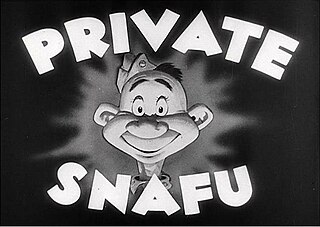
Private Snafu is the title character of a series of black-and-white American instructional adult animated shorts, ironic and humorous in tone, that were produced between 1943 and 1945 during World War II. The films were designed to instruct service personnel about security, proper sanitation habits, booby traps and other military subjects, and to improve troop morale. Primarily, they demonstrate the negative consequences of doing things wrong. The main character's name is a play on the military slang acronym SNAFU, "Situation Normal: All Fucked Up".

Leon Schlesinger was an American film producer who founded Leon Schlesinger Productions, which later became the Warner Bros. Cartoons studio, during the Golden Age of American animation. He was a distant relative of the Warner Brothers. As head of his own studio, Schlesinger served as the producer of Warner's Looney Tunes and Merrie Melodies cartoons from 1930, when Schlesinger assumed production from his subcontractors, Harman and Ising, to 1944, when Warner acquired the studio.

Bosko is an animated cartoon character created by animators Hugh Harman and Rudolf Ising. Bosko was the first recurring character in Leon Schlesinger's cartoon series and was the star of thirty-nine Looney Tunes shorts released by Warner Bros. He was voiced by Carman Maxwell, Bernard B. Brown, Johnny Murray, and Philip Hurlic during the 1920s and 1930s and once by Don Messick during the 1990s.

Hugh Harman was an American animator. He was known for creating the Warner Bros. Cartoons and MGM Cartoons studios and his collaboration with Rudolf Ising during the Golden Age of American animation.
Hugh Harman and Rudolf Ising were an American animation team and company known for founding the Warner Bros. and Metro-Goldwyn-Mayer animation studios. In 1929, the studio was founded under the name Harman-Ising Productions, producing Looney Tunes and Merrie Melodies for Leon Schlesinger from 1930 to 1933. From 1934 to 1938, Harman-Ising produced the Happy Harmonies series, with William Hanna as their employee.
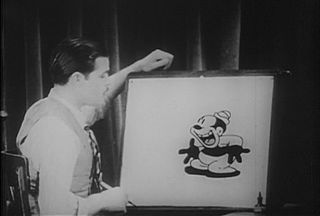
Rudolf Carl "Rudy" Ising was an American animator best known for collaborating with Hugh Harman to establish the Warner Bros. and MGM Cartoon studios during the early years of the golden age of American animation. In 1940, Ising produced William Hanna and Joseph Barbera's first cartoon, Puss Gets the Boot, a cartoon featuring characters later known as Tom and Jerry.
Maurice James Noble was an American animation production designer, background artist and layout designer whose contributions to the industry spanned more than 60 years. He was a long-time associate and right-hand man of animation director Chuck Jones, especially at Warner Bros. in the 1950s. His work contributed to such cartoon classics as Duck Dodgers in the 24½th Century, What's Opera, Doc? and the Road Runner series.
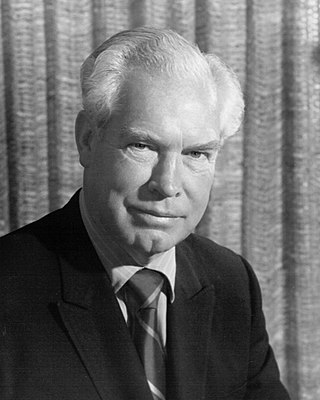
William Denby Hanna was an American animator, voice actor, and occasional musician who is best known for co-creating Tom and Jerry and providing the vocal effects for the series' title characters. Alongside Joseph Barbera, he also founded the animation studio and production company Hanna-Barbera.
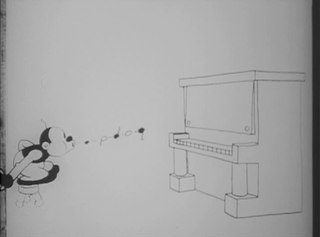
Bosko, the Talk-Ink Kid is a 1929 live-action/animated short film produced to sell a series of Bosko cartoons. The film was never released to theaters, and therefore not seen by a wide audience until 2000 on Cartoon Network's television special Toonheads: The Lost Cartoons. The film was produced on May 29, 1929 and directed by Hugh Harman and Rudolf Ising.
Warner Bros. Cartoons, Inc. was an American animation studio, serving as the in-house animation division of Warner Bros. during the Golden Age of American animation. One of the most successful animation studios in American media history, it was primarily responsible for the Looney Tunes and Merrie Melodies series of animated short films. The characters featured in these cartoons, including Bugs Bunny, Daffy Duck, and Porky Pig, are among the most famous and recognizable characters in the world. Many of the creative staff members at the studio, including directors and animators such as Chuck Jones, Friz Freleng, Robert McKimson, Tex Avery, Robert Clampett, Arthur Davis, and Frank Tashlin, are considered major figures in the art and history of traditional animation.
Willie Whopper is an animated cartoon character created by American animator Ub Iwerks. The Whopper series was the second from the Iwerks Studio to be produced by Pat Powers and distributed through Metro-Goldwyn-Mayer. 14 shorts were produced in 1933 to 1934.
Happy Harmonies is a series of thirty-seven animated cartoons distributed by Metro-Goldwyn-Mayer and produced by Hugh Harman and Rudolf Ising between 1934 and 1938.

The Metro-Goldwyn-Mayer cartoon studio was an American animation studio operated by Metro-Goldwyn-Mayer (MGM) during the Golden Age of American animation. Active from 1937 until 1957, the studio was responsible for producing animated shorts to accompany MGM feature films in Loew's Theaters, which included popular cartoon characters Tom, Jerry, Droopy, Butch, Spike, Tyke, and Barney Bear.

Going Home is part of the Private Snafu series of animated shorts produced by Warner Bros. during World War II. Made in 1944, the 4 minute cartoon features the vocal talents of Mel Blanc and was directed by Chuck Jones. The screenwriters for the Snafu cartoons were typically uncredited, though some animation historians believe that the writer of this short was Dr. Seuss.
Bosko's Picture Show is a Warner Bros. Looney Tunes animated short directed by Hugh Harman and Friz Freleng. It was the last Looney Tunes Bosko cartoon produced by Hugh Harman and Rudolf Ising for Leon Schlesinger and Warner Bros. The duo moved on to produce cartoons for MGM, the first of which were released in 1934. The music score was a work of Frank Marsales.
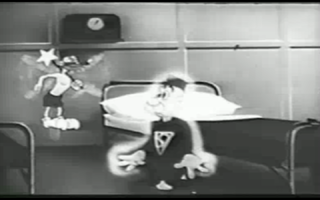
Snafuperman is a 1944 animated short comedy produced by Warner Bros. and directed by Friz Freleng. It is one of a series of black and white "Private Snafu" cartoons created for the Army-Navy Screen Magazine and shown only to American soldiers. The "Private Snafu" cartoons were not released commercially, until December 2010. The cartoon's title is a play on "Superman" and parodies the popular Superman cartoons of the 1940s.
Gas is an animated short, directed by Chuck Jones and first released in May 1944. It features Private Snafu learning the value of a gas mask in warfare. The cartoon was produced by Warner Bros. Cartoons. The script writers for the Snafu cartoons were typically uncredited, though animation historians consider that several of them were written or co-written by Dr. Seuss and Munro Leaf.
Censored is an animated short, directed by Frank Tashlin, produced by Leon Schlesinger and first released in July 1944. It is part of the Private Snafu series.
References
- ↑ Quarterly Update: A Comprehensive Listing of New Audiovisual Materials and Services Offered by the National Audiovisual Center. National Audiovisual Center. April 1988. p. 1.
- 1 2 McBride, Joseph (June 2, 2011). Frank Capra: The Catastrophe of Success. University Press of Mississippi. p. 470. ISBN 9781604738391.
- ↑ Arnold, Gordon B. (November 28, 2016). Animation and the American Imagination: A Brief History. ABC-CLIO. p. 115. ISBN 9781440833601.
- ↑ Cohen, Karl F. (October 18, 2013). Forbidden Animation: Censored Cartoons and Blacklisted Animators in America. McFarland. p. 40. ISBN 9781476607252.
- ↑ Erickson, Hal (July 30, 2012). Military Comedy Films: A Critical Survey and Filmography of Hollywood Releases Since 1918. McFarland. p. 374. ISBN 9780786462902.
- ↑ Cohen, Charles D. (2004). The Seuss, the Whole Seuss, and Nothing But the Seuss: A Visual Biography of Theodor Seuss Geisel . Random House. pp. 249. ISBN 9780375822483.
MGM Private Snafu Harman-Ising.
- ↑ Index of Army Motion Pictures, Film Strips, Slides, and Phono-Recordings. United States Department of the Army. 1959. p. 196.